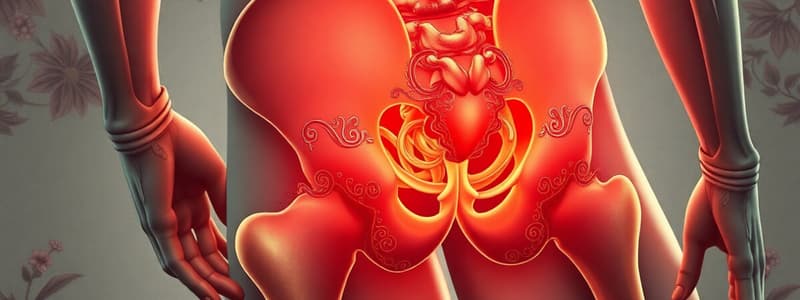Podcast
Questions and Answers
Which symptom is commonly associated with Greater Trochanteric Pain Syndrome?
Which symptom is commonly associated with Greater Trochanteric Pain Syndrome?
- Pain that only occurs during sports
- Swelling in the knee area
- Pain localized to the lateral aspect of the hip (correct)
- Pain when sitting
What condition is characterized by inflammation of the bursal sac?
What condition is characterized by inflammation of the bursal sac?
- Iliotibial Band Syndrome
- Hip osteoarthritis
- Hip Flexor Strain
- Trochanteric Bursitis (correct)
Which treatment is NOT recommended for managing Trochanteric Bursitis?
Which treatment is NOT recommended for managing Trochanteric Bursitis?
- NSAIDs
- Physical Therapy
- Rest
- Surgery (correct)
Which of the following muscles is most commonly injured in adductor strains?
Which of the following muscles is most commonly injured in adductor strains?
Which activity might exacerbate symptoms of Trochanteric Bursitis?
Which activity might exacerbate symptoms of Trochanteric Bursitis?
What is a common underlying cause of adductor strains?
What is a common underlying cause of adductor strains?
What type of symptom is NOT associated with muscle strains?
What type of symptom is NOT associated with muscle strains?
What type of muscle strain can be classified into grades I, II, and III?
What type of muscle strain can be classified into grades I, II, and III?
Which symptom indicates a possible muscle strain?
Which symptom indicates a possible muscle strain?
What activity is typically essential to the treatment of Trochanteric Bursitis?
What activity is typically essential to the treatment of Trochanteric Bursitis?
Flashcards are hidden until you start studying
Study Notes
Greater Trochanteric Pain Syndrome
- Pain localized to the outer aspect of the hip
- Pain worsens with prolonged walking, climbing stairs, lying on the affected or opposite side
- Difficulty starting to walk, or initiating gait, can cause pain
- Common conditions include trochanteric bursitis and external snapping hip
Trochanteric Bursitis
- Inflammation of the bursal sac
- Tenderness to touch, swelling, and warmth
- Treatment includes rest, ice, NSAIDs, and physical therapy (stretching and strengthening)
Trochanteric Bursitis - Etiology
- Common in active individuals
- Inflammation of trochanteric bursae caused by repetitive friction and compression from the iliotibial (IT) band
- Symptoms: inflammation, pain when lying on the affected side, increased pain with activity, relief with rest
- Treatment: manage pain and inflammation, avoid aggravating activities, stretching, strengthen abductor muscles, injections
Other
- Ischial bursitis can occur in cyclists
Muscle Strains
- Groin or adductor strains are the most common type
- The iliopsoas, adductors, and hamstrings are commonly affected
- Of the adductors, the adductor longus is most commonly injured
- Associated with poor conditioning, fatigue, overloading, and muscle imbalances
- Injuries involve the musculotendinous unit, which includes muscles, tendons, and their attachments to bone
- Classified as Grades I, II, and III
- Symptoms include stabbing pain, edema or bruising after injury, pain with passive abduction and resisted adduction, and muscle guarding
Studying That Suits You
Use AI to generate personalized quizzes and flashcards to suit your learning preferences.




